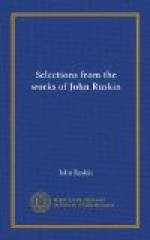[Sidenote: Underlying idea a moral one.]
Now it is clear that a student of the relation of art to life, of work to the character of the workman and of his nation, may, and in fact inevitably must, be led in time to attend to the producer rather than to the product, to the cause rather than to the effect; and if we grant, with Ruskin, that the sources of art, namely, the national life, are denied, it will obviously be the part, not only of humanity but of common sense, for such a student to set about purifying the social life of the nation. Whether the reformation proposed by Ruskin be the proper method of attack is not the question we are here concerned with; our only object at present being to call attention to the fact that such a lecture as that on “Traffic” in The Crown of Wild Olive is the logical outgrowth of such a chapter as “Ideas of Beauty” in the first volume of Modern Painters. Between the author who wrote in 1842, of the necessity of revealing new truths in painting, “This, if it be an honest work of art, it must have done, for no man ever yet worked honestly without giving some such help to his race. God appoints to every one of his creatures a separate mission, and if they discharge it honourably ... there will assuredly come of it such burning as, in its appointed mode and measure, shall shine before men, and be of service constant and holy,"[8] and the author who wrote, “That country is the richest which nourishes the greatest number of noble and happy human beings,"[9] or, “The beginning of art is in getting our country clean, and our people beautiful,"[10]—between these two, I say, there is no essential difference. They are not contradictory but consistent.




